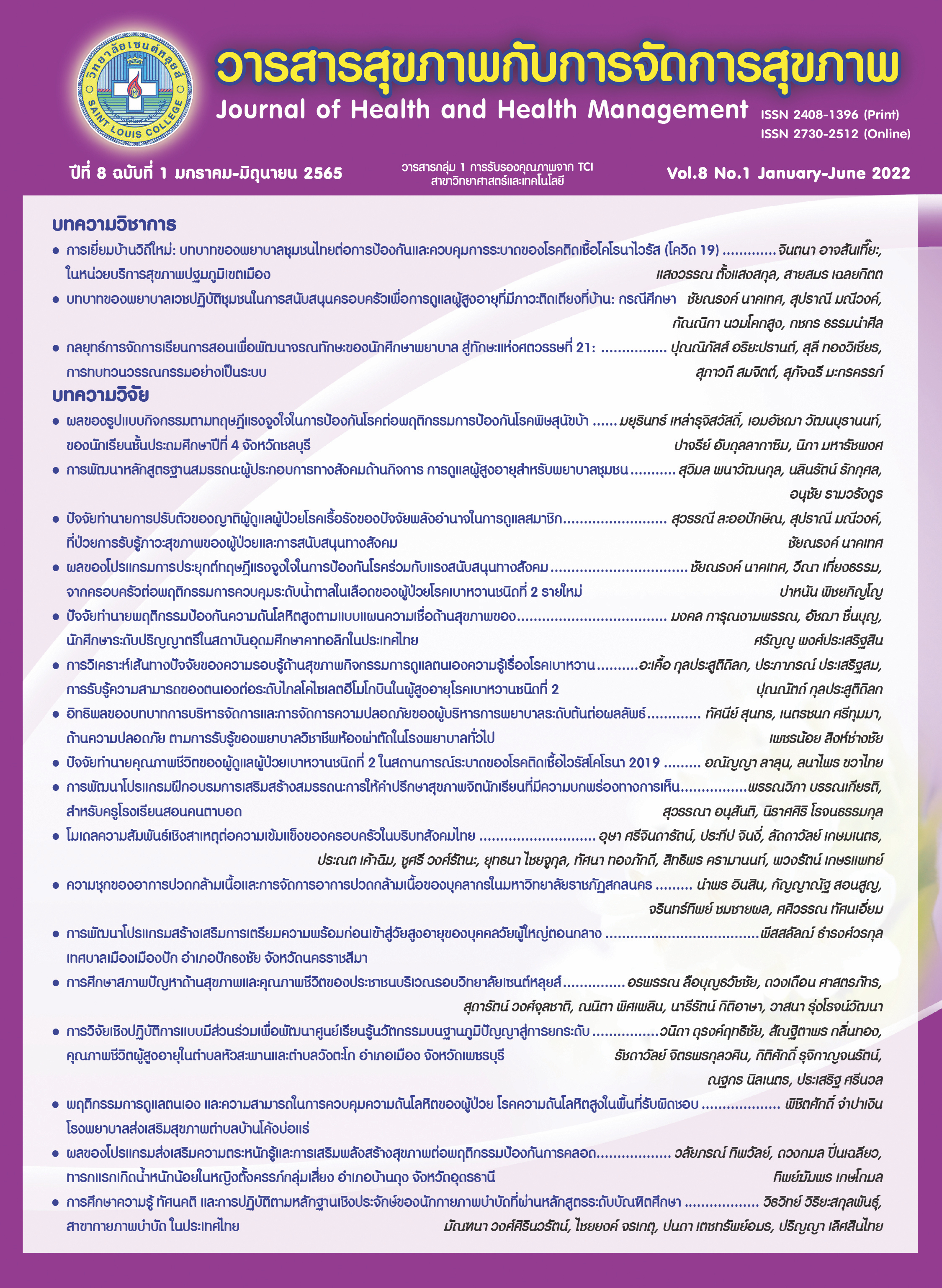Predicting Factors of Adaptation among Family Caregivers of Patients with Chronic Illnesses by the Empowerment in Patient Care, the Caregivers’ Perception in Patient’s Health Status and Social Support
Keywords:
Adaptation, Perceived patient health status, social support, Empowerment in patient caring, CaregiverAbstract
This research aimed at exploring predicting factors of adaptation among family caregivers of patients with chronic illnesses. The sample comprised 198 family caregivers who residing in Sathorn, the urban community in Bangkok. Data were collected by the questionnaires and were analyzed by descriptive and Linear Regression statistics. The results of the study revealed that the majority of the sample were female (65.2%) whose age ranged from 29-67 with the mean age of 55.1. About 42 % of the sample were the patients’ spouse while majority (86.4%) had chronic diseases including musculoskeletal diseases, hypertension, hyperlipidemia, diabetes and cancer. Predicting factors of family caregivers’ adaptation were caregiving ability and social support. Both of these factors can co-predict the variance of adaptation for 57.5%. The predictive model can be composed as follow; Family caregivers’ adaptation = 0.909 - 0.471 caregiving ability - 0 .306 social support + error. From the results of this study, it is recommended that, in order to promote family caregivers’ adaptation, nurses should provide them with proper caregiving information for patients with chronic illnesses. The family caregivers should be encouraged to ensure their confidence in performing patients’ care. Moreover, supports from necessary resources should be provided throughout the caregiving process. In particular, during the first 3 months while the family caregivers are in the early phase of adaptation
References
กองยุทธศาสตร์และแผนงาน สำนักงานปลัดกระทรวงสาธารณสุข. (2563). สถิติสาธารณสุข 2562. [ออนไลน์]. สืบค้นจาก https://dohdatacenter.anamai.moph.go.th/coverpage/fb2723a02584215397a686fd4f49b39a.pdf
จุฑารัตน์ รังษา, ยุวดี รอดจากภัย และไพบูลย์ พงษ์แสงพันธ์.(2559). ผลของโปรแกรมการเสริมสร้างพลังอำนาจของผู้ดูแลและผู้ป่วยสูงอายุโรคเบาหวาน อำเภอกันทรวิชัย จังหวัดมหาสารคาม.ศรีนครินทร์เวชสาร, 31(6), 377-383.
ธีรนันทน์ วรรณศิริ. (2562). พฤติกรรมการดูแลของผู้ดูแลผู้ป่วยเบาหวานในครอบครัว. วารสารพยาบาลสาธารณสุข, 33(2), 76-95.
นิรชา ภูธนารักษ์ และภัควีร์ นาคะวิโร. (2563). ความชุกและปัจจัยที่เกี่ยวข้องกับความรู้สึกเป็นภาระของผู้ดูแลผู้ป่วยโรคหลอดเลือดสมอง. วารสารสมาคมเวชศาสตร์ป้องกันแห่งประเทศไทย,10(1), 1-11.
บุษยมาส บุศยารัศมี. (2561). ความต้องการการดูแลโดยทีมหมอครอบครัวของผู้ดูแลผู้ป่วยโรคหลอดเลือดสมองในเขตเทศบาลนครนครปฐม.วารสารแพทย์เขต 4-5, 37(2), 192-200.
ภาวิณี พรหมบุตร, นพวรรณ เปียซื่อ และสมนึก สกุลหงส์โสภณ. (2563). ปัจจัยที่มีความสัมพันธ์กับความเครียดในผู้ดูแลผู้ป่วยโรคหลอดเลือดสมองที่บ้าน. รามาธิบดีพยาบาลสาร, 20(1), 82-96.
ยุซรอ เล๊าะแม, วันธณี วิรุฬห์พานิช และพิสมัย วัฒนสิทธิ์.(2559). ความสัมพันธ์ระหว่างภาระการดูแล แรงสนับสนุนทางสังคมและคุณภาพชีวิตของมารดาที่มีเด็กโรคหัวใจพิการแต่กำเนิด.วารสารวิจัยการพยาบาลและสุขภาพ, 17(2), 27-42.
วัจนา ลีละพัฒนะ และ สายพิณ หัตถีรัตน์. (2559).สําานักข่าว Hfocus เจาะลึกระบบสุขภาพ “เมื่อผู้ดูแลทำไม่ไหวแล้ว (Working with caregiver burnout)”. สืบค้นจาก https://www.hfocus.org/content/2016/06/12274#comment-0.
วิภา เพ็งเสงี่ยม. (2560). การพัฒนาโปรแกรมการสร้างเสริมพลังอำนาจของผู้ดูแลผู้สูงอายุติดเตียงในชุมชน. วารสารการพยาบาลการสาธารณสุขและการศึกษา, 18(3), 83-95.
ศิริอร สินธุ, ปทุมทิพย์ อดุลวัฒนศิริ, เกศรินทร์ อุทริยะประสิทธิ์, รวมพร คงกำเนิด และวรรณวลี คชสวัสดิ์.(2563). การสังเคราะห์ข้อเสนอเชิงนโยบายในการพัฒนารูปแบบบริการปฐมภูมิเพื่อดูแลผู้ป่วยโรคหลอดเลือดสมอง: กรุงเทพมหานคร.สืบค้น จาก https://kb.hsri.or.th/dspace/handle/11228/5180?locale-attribute=th.
สุภาพร แนวบุตร. (2558). ผลของโปรแกรมการเสริมพลังอำนาจต่อความสามารถในการดูแลตนเองของผู้ดูแลผู้ป่วยในครอบครัว. วารสารการพยาบาลและการศึกษา, 8(4), 30-40.
สุปรีดา มั่นคง, ยุพาพิน ศิรโพธิ์งาม และศุภร วงศ์วทัญญู.(2559). บทบาทของผู้ดูแลผู้ป่วยที่ได้รับ การดูแลแบบประคับประคอง: การศึกษาเบื้องต้นเชิงคุณภาพ. วารสารสภาการพยาบาล, 31(4), 104-121.
สุวรรณี ละออปักษิณ. (2562). รายงานโครงการบริการวิชาการสู่สังคม 7 ปี การสนับสนุนการช่วยเหลือตนเองของครอบครัวที่มีปัญหาโรคเรื้อรัง.วิทยาลัยเซนต์หลุยส์: กรุงเทพฯ.
สันติชัย ฉำจิตรชื่น. (2558). “Crisis Intervention”. สืบค้น จาก https://med.mahidol.ac.th/ramamental/sites/default/files/public/pdf/Crisis%20Intervention.pdf
สำนักยุทธศาสตร์และประเมินผล กรุงเทพมหานคร.(2553). แผนยุทธศาสตร์การพัฒนาสุขภาพคนเมืองกรุงเทพมหานคร2553-2556. กรุงเทพฯ: สำนักยุทธศาสตร์และประเมินผลกรุงเทพมหานคร.
อรุณี ชุณหบดี, ธิดารัตน์ สภานันท์, โรชินี อุปรา และสุนารีภรณ์ ทองไสย. (2556). ความเครียดและความต้องการของผู้ดูแลผู้ป่วยโรคหลอดเลือดสมองที่บ้าน. วารสารวิทยาลัยพยาบาลพระปกเกล้า.21(1), 1-9.
Aguilera D.C., and Messick J.M. (1982). Crisis Intervention theory and methodology. Missouri: The C.V. Mosby Company.
Cameron, J.I., Naglie, G., Silver, F. L., & Gignac, M. A. (2013). Stroke family caregivers' support needs change across the care continuum: A qualitative study using the timing it right framework. Disability & Rehabilitation, 35, 315-324. doi:10.3109/09638288.2012.691937. https://doi.org/10.3109/09638288.2012.691937
Cohen J. (1997). Statistical power for the behavioral sciences. (2nd ed). NY: Academic Press.
Dixey, R.(2013). Health promotion: global principles and practice.Wallingford, Oxfordshire: CABI. https://doi.org/10.1079/9781845939724.0000
Gordon, JR., Pruchno, RA., Wilson-Genderson, M., Murphy, WM., and Rose, M. (2012). Balancing Caregiving and Work: Role Conflict and Role Strain Dynamics.J Fam Issues.33(5), 662-689. https://doi.org/10.1177/0192513X11425322
Gottlieb, JL. (1985). Social participation of individuals in four rural community of the northeast: rural sociology. 4th ed. Columbia: University Missouri Press.
House, JS. (2001). Social isolation kills-but how and why. Psycho Med, 63, 273-274. https://doi.org/10.1097/00006842-200103000-00011
Jaracz, K., Grabowska-Fudala, B., Gorna, K., Jaracz, J., Moczko, J. & Kozubski, W. (2015). Burden in Caregivers of Long-Term Stroke Survivors: Prevalence and Determinants at 6 months and 5 Years After Stroke. Patient Counselling and Health Education, 98(8), 1011-1016. https://doi.org/10.1016/j.pec.2015.04.008
Kim, J., Han, Jeong Y., Shaw, BR., McTavish, FM., Gustafson DH. (2010). The Roles of Social Support and Coping Strategies in Predicting Breast Cancer Patients' Emotional Well-being: Testing Mediation and Moderation Models. J Health Psycho,15(4): 543-552. https://doi.org/10.1177/1359105309355338
Liu, Z., Heffernan, C., Tan, J. (2020). Caregiver burden: A concept analysis. International Journal of Nursing Sciences. 7(4): 438-445. https://doi.org/10.1016/j.ijnss.2020.07.012
Lundy, KS., & Janes, S. (2016). Community Health Nursing: Caring for the Public's Health. (3rd ed.). Massachusetts: Jones & Bartlett Learning.
Maurer, FA., & Smith, CM. (2013). Community/public health nursing practice: health for families and populations (5th ed.). St. Louis, Mo.: Elsevier/Saunders.
Nickerson, C. (2021). What is role strain? definition and examples. Simply Psychology. Retrieved from: https://www.simplypsychology.org/what-is-role-strain-in-sociology.html.
Orem DE. (1980). Nursing: concepts of practice (2nd ed). New York: McGraw-Hill.Rohrbaugh, M. J. (2021). Contructing We-ness: A communal Coping Intervention for Couples Facing Chronic Illness. Famjly Process. 61(1), 17-31. https://doi.org/10.1111/famp.12595
Ryan & McKenna, H. (2013). Familiarity as a key factor influencing rural family cares' experience of nursing home placement of an older relative: a qualitative study. Retrieved from https://bmchealthservres.biomedcentral.com/articles/10.1186/1472-6963-13-252. https://doi.org/10.1186/1472-6963-13-252
Seaward, BL. (2006). Managing Stress: Principles and Strategies for Health and Wellbeing. Portland, OR: Book News, Inc.
Spreitzer, G. M. (1995). Psychological empowerment in the workplace: Dimensions, measurement, and validation. Academy of Management Journal, 38(5): 1442-1465. https://doi.org/10.5465/256865
Zarit, SH., Todd, PA., & Zarit, JM. (1986) Subjective Burden of Husbands and Wives as Caregivers: A Longitudinal Study. Gerontologist, 26, 260-266. https://doi.org/10.1093/geront/26.3.260
Downloads
Published
How to Cite
Issue
Section
License
Copyright (c) 2022 Journal of health and health management

This work is licensed under a Creative Commons Attribution-NonCommercial-NoDerivatives 4.0 International License.




